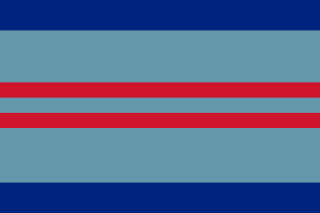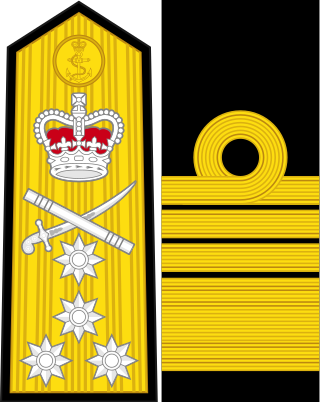Commodore is a senior naval rank used in many navies which is equivalent to brigadier or brigadier general and air commodore. It is superior to a navy captain, but below a rear admiral. It is either regarded as the most junior of the flag officers rank or may not hold the jurisdiction of a flag officer at all depending on the officer's appointment. Non-English-speaking nations commonly use the rank of flotilla admiral, counter admiral, or senior captain as an equivalent, although counter admiral may also correspond to rear admiral lower half abbreviated as RDML.
Vice admiral is a senior naval flag officer rank, usually equivalent to lieutenant general and air marshal. A vice admiral is typically senior to a rear admiral and junior to an admiral.
Rear admiral is a senior naval flag officer rank, equivalent to a major general or divisional general and air vice marshal and above that of a commodore and captain, but below that of a vice admiral.

Air vice-marshal (AVM) is a two-star air officer rank which originated in and continues to be used by the Royal Air Force. The rank is also used by the air forces of many countries which have historical British influence and it is sometimes used as the English translation of an equivalent rank in countries which have a non-English air force-specific rank structure.
A flag officer is a commissioned officer in a nation's armed forces senior enough to be entitled to fly a flag to mark the position from which the officer exercises command.

Admiral is a senior rank of the Royal Navy, which equates to the NATO rank code OF-9, outranked only by the rank of admiral of the fleet. Royal Navy officers holding the ranks of rear admiral, vice admiral and admiral of the fleet are sometimes considered generically to be admirals. The rank of admiral is currently the highest rank to which a serving officer in the Royal Navy can be promoted, admiral of the fleet being in abeyance except for honorary promotions of retired officers and members of the Royal Family.
Admiral is a four-star commissioned officer rank in the United States Navy, the United States Coast Guard, and the United States Public Health Service Commissioned Corps with the pay grade of O-10. Admiral ranks above vice admiral and below fleet admiral in the Navy; the Coast Guard and the Public Health Service do not have an established grade above admiral. Admiral is equivalent to the rank of general in the other uniformed services. The National Oceanic and Atmospheric Administration Commissioned Officer Corps has never had an officer hold the grade of admiral. However, 37 U.S.C. § 201 of the U.S. Code established the grade for the NOAA Corps, in case a position is created that merits the four-star grade.
The Indian Navy (IN), the naval component of the Indian Armed Forces follows a certain hierarchy of rank designations and insignia derived from the erstwhile Royal Indian Navy (RIN).

A five-star rank is the highest military rank in many countries. The rank is that of the most senior operational military commanders, and within NATO's standard rank scale it is designated by the code OF-10. Not all armed forces have such a rank, and in those that do the actual insignia of the five-star ranks may not contain five stars. For example: the insignia for the French OF-10 rank maréchal de France contains seven stars; the insignia for the Portuguese marechal contains four gold stars. The stars used on the various Commonwealth of Nations rank insignias are sometimes colloquially referred to as pips, but in fact either are stars of the orders of the Garter, Thistle or Bath or are Eversleigh stars, depending on the wearer's original regiment or corps, and are used in combination with other heraldic items, such as batons, crowns, swords or maple leaves.

Vice admiral is the second-highest active rank of the Royal Australian Navy (RAN). It is a three-star rank, and was created as a direct equivalent of the British rank of vice admiral. The rank is held by the Chief of Navy and, when the positions are held by navy officers, by the Vice Chief of the Defence Force, the Chief of Joint Operations, the Chief of Joint Capabilities, or equivalent position.

Rear admiral is the third-highest active rank of the Royal Australian Navy and was created as a direct equivalent of the British rank of rear admiral. It is a two-star rank.
Vice Admiral (VAdm) is a flag officer rank of the Royal Navy and equates to the NATO rank code OF-8. It is immediately superior to the rear admiral rank and is subordinate to the full admiral rank.
Rear admiral (RAdm) is a flag officer rank of the Royal Navy. It is immediately superior to commodore and is subordinate to vice admiral. It is a two-star rank and has a NATO ranking code of OF-7.
The Military ranks of Turkey are the military insignia used by the Turkish Armed Forces.

Admiral is a four-star naval flag officer rank in the Indian Navy. It is the highest active rank in the Indian Navy. Admiral ranks above the three-star rank of vice admiral and below the five-star rank of admiral of the fleet, which has never been awarded or held.

Vice admiral is a three-star flag officer rank in the Indian Navy. It is the second-highest active rank in the Indian Navy. Vice admiral ranks above the two-star rank of rear admiral and below the four-star rank of admiral, which is held by the Chief of the Naval Staff (CNS).
Vice admiral is a three-star commissioned naval officer rank in the Swedish Navy. Vice admiral ranks above rear admiral and below admiral. Vice admiral is equivalent to the rank of lieutenant general.
Rear admiral (RAdm) (Swedish: Konteramiral, Kam) is a two-star commissioned naval officer rank in the Swedish Navy. Rear admiral ranks above rear admiral (lower half) and below vice admiral. Rear admiral is equivalent to the rank of major general.

Rear admiral is a two-star flag officer rank in the Indian Navy. It is the third-highest active rank in the Indian Navy. Rear admiral ranks above the one-star rank of commodore and below the three-star rank of vice admiral.










